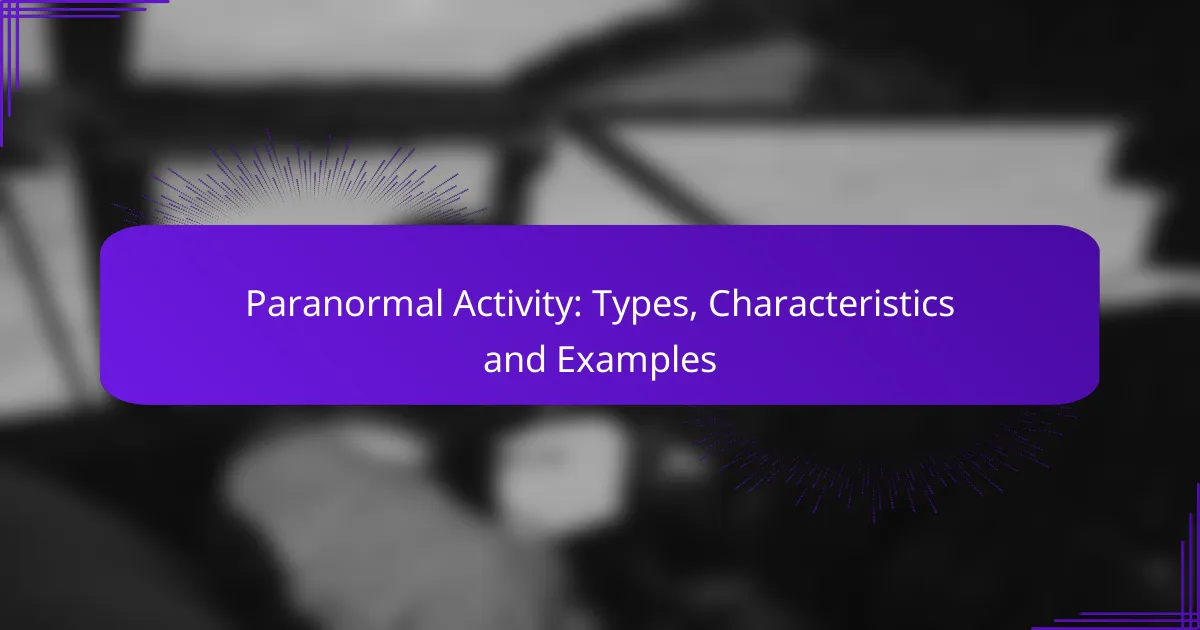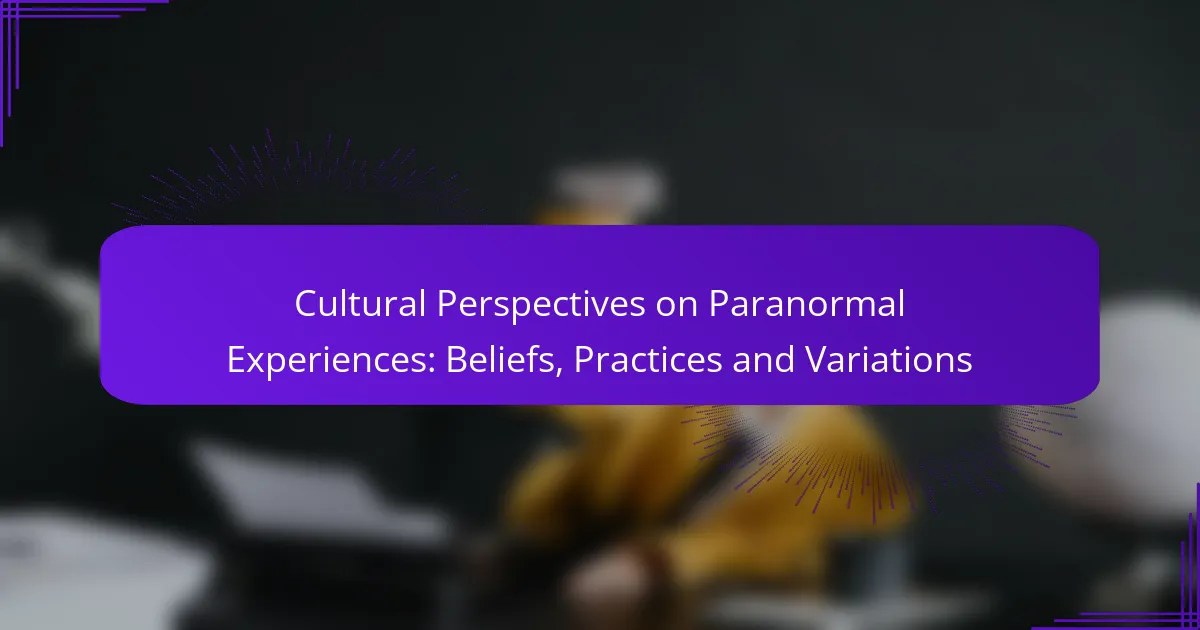Paranormal activity refers to phenomena that challenge our understanding of the natural world, including ghosts, poltergeists, UFO sightings, and cryptids. Each type exhibits distinct characteristics and has sparked curiosity and debate among both believers and skeptics. Common examples, such as hauntings and ghost sightings, often involve eerie sounds and apparitions, captivating those who encounter them.
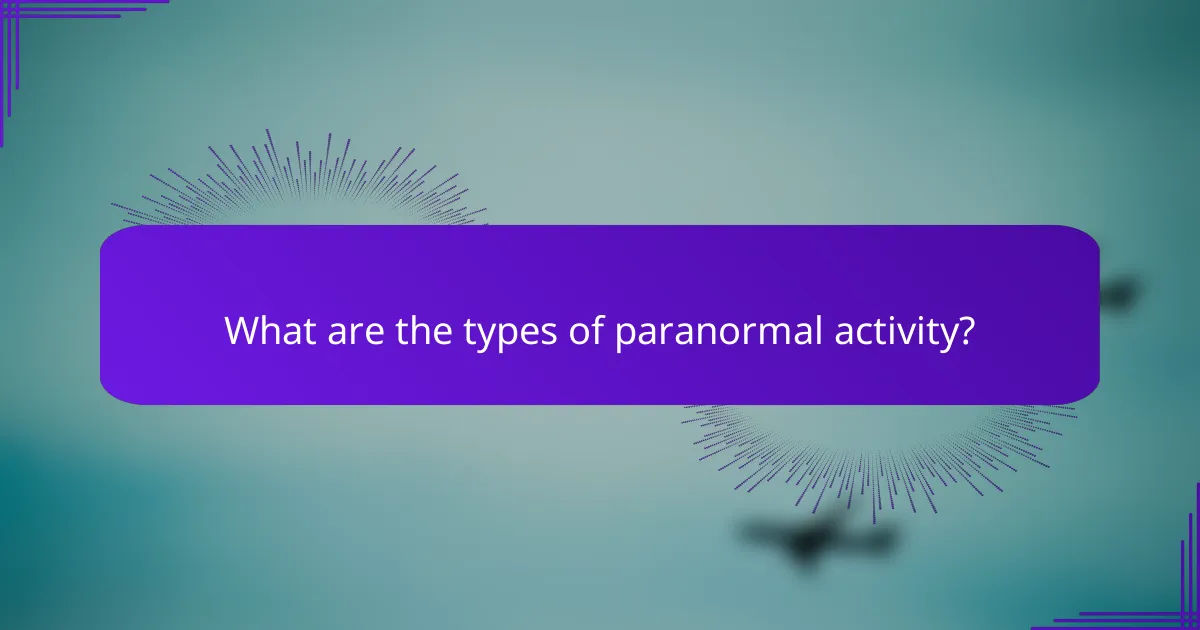
What are the types of paranormal activity?
Paranormal activity encompasses a variety of phenomena that defy conventional scientific explanation. The main types include ghosts, poltergeists, UFO sightings, cryptids, and hauntings, each with unique characteristics and examples.
Ghosts
Ghosts are often described as the spirits or souls of deceased individuals that remain on Earth. They are typically associated with specific locations or events and may manifest through sightings, sounds, or other sensory experiences.
Common examples of ghostly encounters include apparitions, unexplained noises, and cold spots in certain areas. Many cultures have their own interpretations of ghosts, often influenced by local folklore and beliefs.
Poltergeists
Poltergeists are a specific type of paranormal activity characterized by physical disturbances, such as objects moving or being thrown without apparent cause. Unlike traditional ghosts, poltergeist activity often involves more aggressive manifestations.
These phenomena are frequently linked to individuals, particularly adolescents, who may unknowingly be the source of the disturbances due to emotional or psychological stress. Reports of poltergeist activity can include loud noises, furniture rearrangement, and even physical harm.
UFO sightings
UFO sightings refer to observations of unidentified flying objects, which some believe to be extraterrestrial spacecraft. These sightings often generate significant interest and debate regarding their origins and implications.
Common characteristics of UFO sightings include unusual flight patterns, bright lights, and silent movement. While many sightings can be attributed to natural or man-made phenomena, a small percentage remain unexplained, fueling speculation about alien life.
Cryptids
Cryptids are creatures whose existence is based on anecdotal evidence and folklore rather than scientific proof. Examples include Bigfoot, the Loch Ness Monster, and the Chupacabra, each with a rich history of reported sightings.
Interest in cryptids often stems from local legends and cultural narratives. While many cryptids are considered hoaxes or myths, some enthusiasts continue to search for evidence to support their existence, often leading to expeditions and investigations.
Hauntings
Hauntings are typically associated with locations where paranormal activity is reported, often linked to tragic events or historical significance. These locations may exhibit repeated phenomena, such as ghostly apparitions or unexplained sounds.
Commonly haunted places include old buildings, battlefields, and historic sites. Investigations often involve paranormal teams using tools like EMF meters and EVP recorders to capture evidence of these activities, though results can vary widely in credibility.
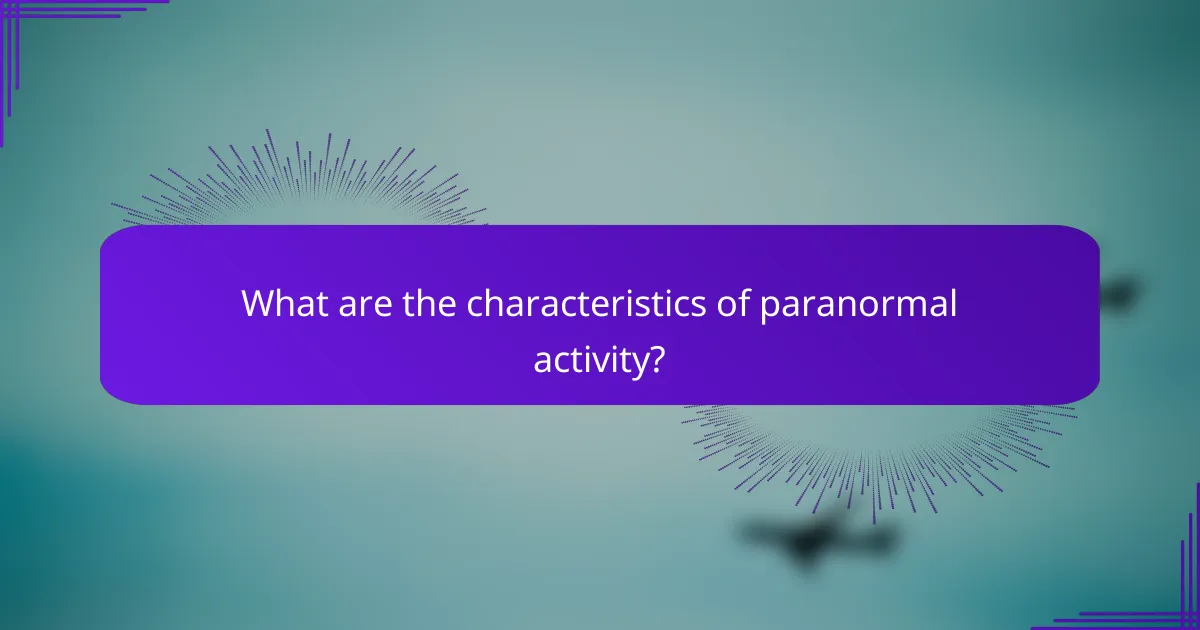
What are the characteristics of paranormal activity?
Paranormal activity is characterized by events or phenomena that cannot be easily explained by current scientific understanding. These occurrences often involve unusual experiences that challenge the natural laws as we know them.
Unexplained phenomena
Unexplained phenomena are the cornerstone of paranormal activity, encompassing events like apparitions, poltergeist activity, and mysterious sounds. These occurrences often lack a logical explanation and can happen in various settings, from homes to public spaces.
Examples include objects moving without apparent cause or sudden temperature drops in a room. Such phenomena typically elicit strong emotional responses from witnesses, further complicating their understanding.
Witness testimonies
Witness testimonies are crucial in establishing the credibility of paranormal claims. Individuals often report personal experiences that include feelings of being watched, seeing ghostly figures, or hearing disembodied voices.
These accounts can vary widely, with some witnesses describing vivid details while others provide more ambiguous descriptions. The subjective nature of these experiences can make it challenging to validate or debunk them scientifically.
Environmental anomalies
Environmental anomalies refer to unusual changes in the surroundings that accompany paranormal activity. This can include fluctuations in electromagnetic fields, unexplained cold spots, or unusual sounds that cannot be attributed to natural causes.
For instance, some investigators use electromagnetic field meters to detect spikes in energy levels during reported paranormal events. These anomalies often serve as indicators that something beyond normal physical explanations may be occurring.
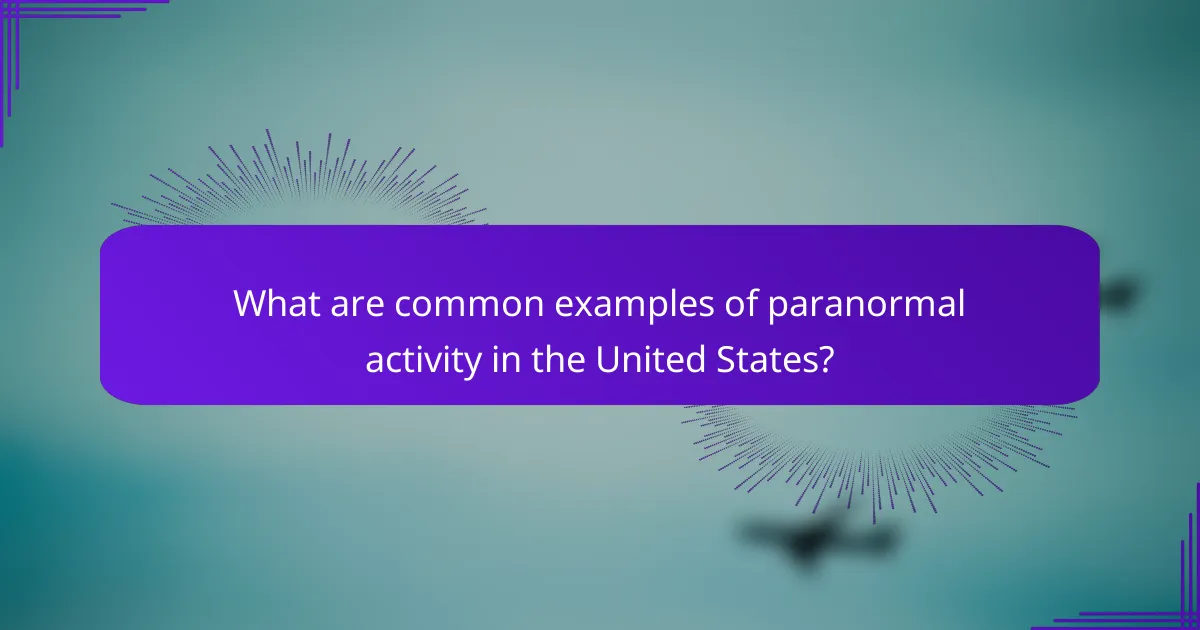
What are common examples of paranormal activity in the United States?
Common examples of paranormal activity in the United States include hauntings, ghost sightings, and unexplained phenomena often linked to specific locations. These events typically involve eerie sounds, apparitions, or other supernatural occurrences that have intrigued both believers and skeptics alike.
The Amityville Horror
The Amityville Horror refers to a series of alleged supernatural events experienced by the Lutz family in their home in Amityville, New York, after a gruesome murder took place there in 1974. The family reported strange noises, cold spots, and even apparitions, which led to widespread media coverage and a popular horror film franchise.
This case is notable for its impact on public perception of paranormal activity, as it sparked debates about the authenticity of the Lutz family’s claims and the nature of hauntings. The Amityville Horror remains a significant example of how a single event can influence cultural views on the supernatural.
The Winchester Mystery House
The Winchester Mystery House in San Jose, California, is a sprawling mansion known for its architectural curiosities and alleged hauntings. Built by Sarah Winchester, the widow of firearm magnate William Wirt Winchester, the house features numerous oddities, such as staircases leading to nowhere and doors opening into walls, which are said to have been constructed to appease the spirits of those killed by Winchester rifles.
Visitors often report feelings of unease and unexplained phenomena during tours, contributing to the house’s reputation as a haunted location. The Winchester Mystery House serves as a fascinating case study of how personal tragedy and belief in the supernatural can shape architectural design.
Skinwalker Ranch
Skinwalker Ranch, located in Utah, is infamous for its reports of paranormal activity, including UFO sightings, strange creatures, and unexplained phenomena. The ranch has been the subject of numerous investigations, with researchers documenting a variety of bizarre occurrences, such as cattle mutilations and mysterious lights in the sky.
This location is tied to Native American folklore, particularly the legend of the Skinwalker, a shape-shifting witch. The combination of cultural significance and reported supernatural events makes Skinwalker Ranch a focal point for those interested in the intersection of folklore and modern paranormal investigations.
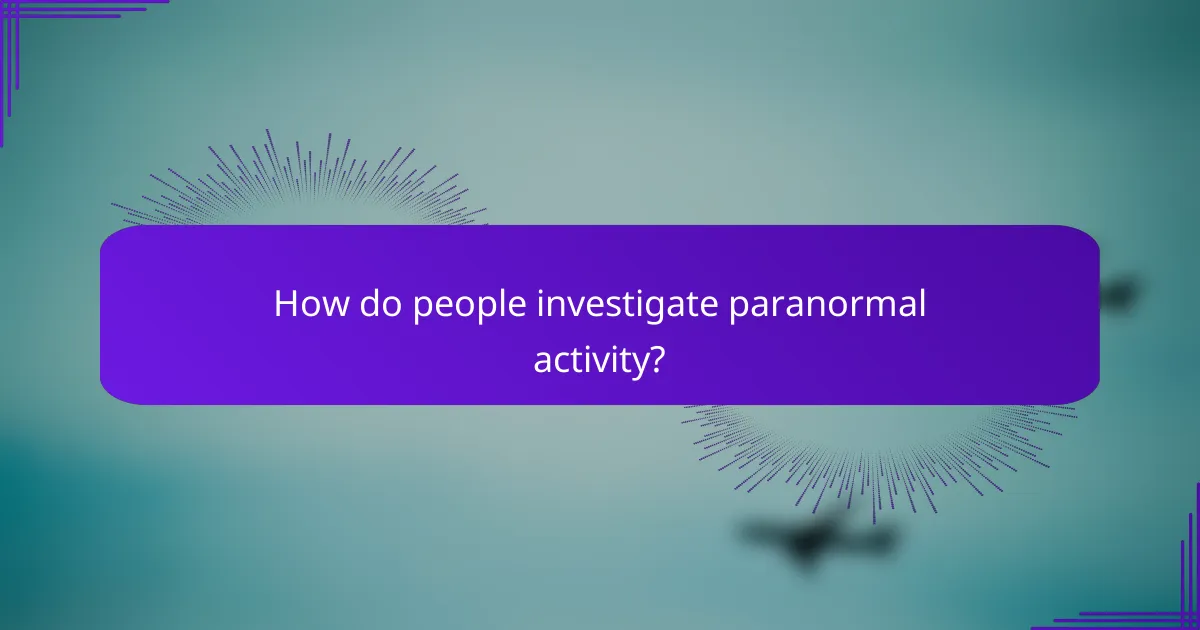
How do people investigate paranormal activity?
People investigate paranormal activity through various methods that combine technology, personal experiences, and research techniques. These investigations aim to gather evidence and understand phenomena that defy conventional explanations.
Using ghost hunting equipment
Ghost hunting equipment includes tools designed to detect and record paranormal phenomena. Common devices are EMF meters, infrared thermometers, and digital cameras, which help investigators identify unusual energy fluctuations, temperature changes, and visual anomalies.
When using this equipment, it’s essential to ensure proper calibration and understand the limitations of each device. For instance, EMF meters can pick up electrical interference, which may lead to false positives. Always cross-reference findings with other evidence.
Conducting EVP sessions
Electronic Voice Phenomena (EVP) sessions involve using audio recording devices to capture voices or sounds that are not audible during the recording. Investigators typically ask questions and leave pauses for potential responses, which are later analyzed for anomalies.
To increase the chances of capturing EVPs, choose quiet locations and avoid background noise. Use high-quality recording equipment and listen carefully during playback, as some responses may be faint or require enhancement for clarity.
Field research and interviews
Field research and interviews involve gathering firsthand accounts from individuals who have experienced paranormal events. This qualitative approach helps build a narrative and context around the phenomena being investigated.
When conducting interviews, ask open-ended questions to encourage detailed responses. Document the interviews thoroughly, noting any patterns or recurring themes that may emerge. This information can provide valuable insights and guide further investigations.

What criteria should be considered when evaluating paranormal claims?
When evaluating paranormal claims, it is essential to consider the credibility of witnesses, the presence of physical evidence, and the historical context surrounding the events. These criteria help determine the reliability and significance of the claims made.
Credibility of witnesses
The credibility of witnesses plays a crucial role in assessing paranormal claims. Factors such as the witness’s background, reputation, and potential biases should be examined. Reliable witnesses often have a history of honesty and integrity, which can lend weight to their accounts.
Additionally, the consistency of their testimonies over time is important. If multiple witnesses provide similar accounts, it can enhance the credibility of the claims. However, discrepancies or changes in their stories may raise doubts.
Physical evidence
Physical evidence is a key component in evaluating paranormal claims. This can include photographs, videos, audio recordings, or tangible artifacts that support the claim. The quality and authenticity of such evidence must be scrutinized to determine its validity.
For instance, high-resolution images or clear audio recordings can provide compelling support for a claim, while blurry photos or low-quality recordings may be dismissed as inconclusive. It’s also important to consider how the evidence was collected and whether it has been tampered with.
Historical context
Understanding the historical context of paranormal claims can provide valuable insights. This includes examining local folklore, previous incidents, and cultural beliefs that may influence perceptions of the paranormal. Historical accounts can either support or contradict current claims.
For example, if a location has a long history of reported paranormal activity, it may lend credibility to new claims. Conversely, if a claim contradicts established historical facts, it may warrant skepticism. Contextualizing claims within their historical framework helps in making informed evaluations.
